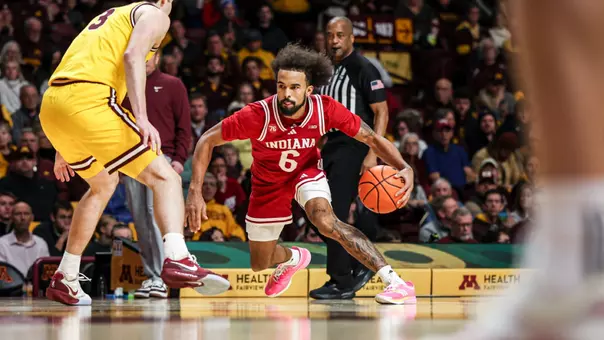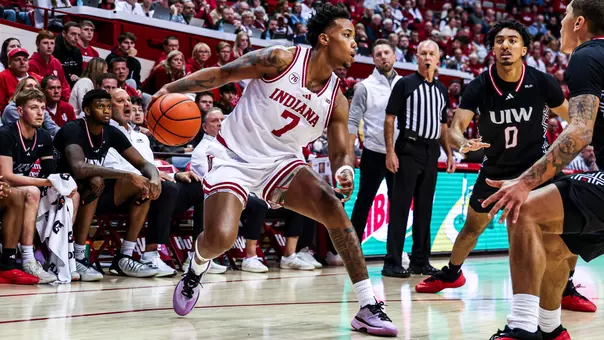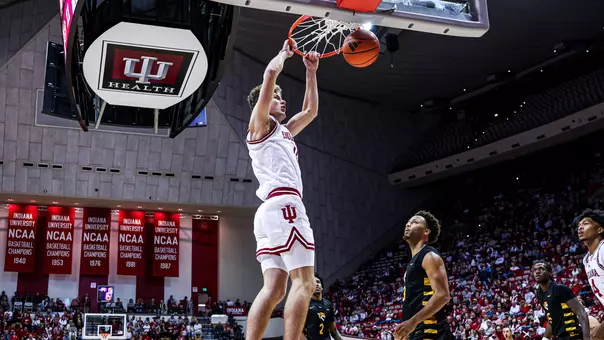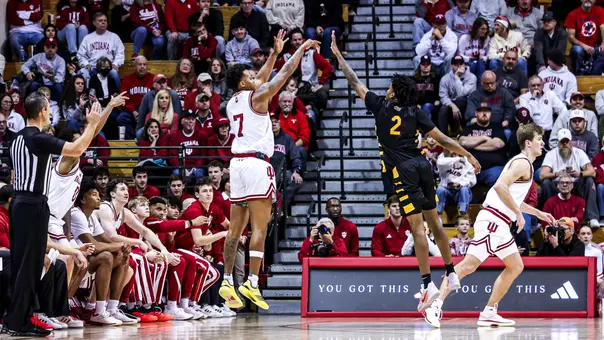Indiana University Athletics
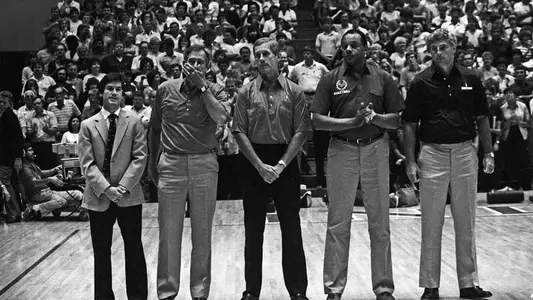
Gold Standard Part 2: Knight Assembles Team to Remember in '84
4/7/2020 7:15:00 AM | Men's Basketball, History
Note: IU Athletics is partnering with IU Press to share chapters from some of their recently-published books on IU Sports. The following is the second half of a chapter from Unknown, Untold, and Unbelievable Stories about IU Sports, published by IU Press in 2018. The first half of the chapter can be found here. Additional details about this book can be found here.
By the time the 1984 NBA Draft had concluded and the players left the WTTV studio, eight of the 16 players still under consideration for the U.S. squad had their lives changing significantly. Jordan's initial contract included a $1 million signing bonus as part of a five-year, $6 million deal. Even the last of the U.S. Olympic Trials participants selected – Fleming – was set to earn $200,000 in his rookie season.
But according to Garl, Knight managed to keep the players' focus on Los Angeles and the quest for a gold medal.
"Coach didn't deny (the Draft) happened," Garl said. "But he said, 'hey, you need to do the Olympic thing first. We have a job to do.'"
Knight's message was heard, and the team's focus didn't waiver. Shortly after the NBA Draft, Knight cut the final four players – Lancaster Gordon, Johnny Dawkins, Chuck Person and Tim McCormick – on June 27 to get the roster down to the final 12. From there the team embarked on a coast-to-coast tour of exhibition games in preparation for the Olympics. Included was a July 9 match-up against NBA All-Stars at the Hoosier Dome in Indianapolis that drew 67,596 fans – a total that established a new record for the largest crowd to ever witness a basketball game.
"A game in July in the heat and humidity of summer draws 67,596 fans? Where else but Indiana?" says IU Assistant Athletic Director Chuck Crabb, who served as the public address announcer at the game and later as the Press Center Interview Manager at the Los Angeles Games.
***
 Team USA rolled through its competition once it arrived in Los Angeles. Robertson scored 18 to lead the team to a 48-point win over China in its opener. Jordan, Ewing and Alford then led Team USA in scoring in the next three games as the squad continued to demolish its foes in group play, easily qualifying them for the medal round.
Team USA rolled through its competition once it arrived in Los Angeles. Robertson scored 18 to lead the team to a 48-point win over China in its opener. Jordan, Ewing and Alford then led Team USA in scoring in the next three games as the squad continued to demolish its foes in group play, easily qualifying them for the medal round.
The team's quarterfinal opponent – West Germany – proved to be the stiffest competition during the Games, pushing Team USA before falling, 78-67. The West German team featured not only future NBA standout Detlef Schrempf, but also Hoosier junior Uwe Blab, who scored 10 points against Knight's U.S. squad.
The biggest thing Team USA had to overcome in that game, though, wasn't Schrempf or Blab, but a bad tooth. Garl said that Jordan had been dealing with a toothache before the game, something they kept quiet.
"I took him to the dentist and they worked on him a little bit and we went back to workouts, and afterwards he was still hurting," Garl said. "So I took him back and they ended up doing an extraction. So he had a tooth pulled before the game and didn't play that well (Jordan had 14 points and a game-high six turnovers). No one ever said anything about the tooth."
With the tooth gone and the West Germans dispatched, Team USA proceeded to whip Canada in the semifinals by 21 to set up a Gold Medal match-up with Spain.
On the court, there was little drama in the championship game, as Team USA cruised to a 99-65 win to claim the gold medal. The nervous moments, though, came before the game when the squad was warming up.
"It's one of the great stories that people have probably never heard of," said Garl.
Throughout the Games, Team USA's players and staff stayed in the Olympic Village on the University of Southern California campus. Depending on traffic, the USC campus was a 20-30 minute drive from men's basketball venue, The Forum in Inglewood.
As the team was warming up for the Gold Medal game, Garl noticed a problem – underneath his warm-up, Jordan was wearing the wrong color uniform. Since the players dressed before heading over to the game, Jordan's white jersey was back in his room in the Olympic Village.
The staff immediately sprang into action. Team USA assistant and Dayton University coach Don Donoher grabbed a sheriff's officer and the pair raced back to the USC campus. Garl, meanwhile, phoned the dormitory and told a close friend who was a member of the medical staff about the situation and instructed him to tell security to let him into Jordan's room so he could grab his white jersey, and then he was instructed to and it off to Donoher and the officer in the lobby.
That plan would have succeeded if not for one small issue.
"I hadn't had a chance to tell Donoher they'd have the jersey in the lobby waiting for him," Garl said.
So the security officer goes into Jordan's room, they get the jersey, and they return to the lobby. Donoher, meanwhile, races through the lobby and up to Jordan's room. He tears through Jordan's belongings, unable to find the correct uniform.
As Donoher is searching for the jersey, the member of the medical staff with the jersey grew nervous, as he knew game time was approaching.
"He ends up grabbing another officer and says, 'hey, we got to go,'" Garl said. "They have to have this to start the game."
So the trainer and the second officer race through Los Angeles and Olympic traffic to The Forum, arriving in time for Jordan to switch uniforms before tip-off. Soon afterwards, Donoher returns and heads to Garl.
"He's like, 'I searched everywhere, high and low, that jersey wasn't there,'" Garl said. "I said, 'Don, I'm sorry, we had it all set, you missed each other in the lobby, and they panicked and drove out here and we got it resolved.'"
That near miss did little to distract Jordan or the team before they took the court against Spain. In the final moments before the team took the court for the gold medal game, Knight did what he traditionally did for all games – he began writing the offensive and defensive priorities on the locker room chalkboard. As he was writing Jordan interrupted his pre-game ritual.
"Jordan said, 'Coach, never mind this, we're ready to play,'" Garl recalls. "It's not necessary."
It wasn't – Jordan scored 20 points to lead Team USA to the 99-65 win.
***
It was a team that will forever hold its own among the great amateur basketball teams ever assembled. While there always would have been a special place in the hearts of Hoosiers for the squad thanks to the presence of Alford on the roster and Knight on the sidelines, the decision to hold the Olympic Trials in Bloomington makes it even more special.
According to Garl, that was a decision Knight made, and it ran contrary to the norm of taking players to the U.S. Olympic Committee headquarters in Colorado Springs, Col. But there was no pushback from USA Basketball.
"The guys at the head of USA Basketball said it's your team, we don't want to present any obstacles or give you any problems," Garl said. "They didn't want anyone to have any regrets."
So with that decision cleared, 73 players and many of the nation's premier college coaches descended on Bloomington in April of 1984. The players stayed at the IU Memorial Union, and Garl still has the original rooming list (one of the more interesting roommate tandems on the alphabetized list was Barkley and Alford). Among those who stayed at the Union was Garl, who offered up his house to members of the coaching staff to use.
It created a very special environment in Bloomington, according to Crabb.
"You had all of basketball's attention on Bloomington," Crabb said.
While the pursuit of the gold medal was the focus of both players and coaches during their Bloomington stays, Knight didn't prevent the players from getting around town. The city was well-versed in the sport of college basketball, and the players were celebrities once they ventured away from the practice courts and mingled with the members of the community.
"(The players) found Ye Old Regulator, they found Nick's," Crabb recalls. "They enjoyed what night life there is in Bloomington."
That was particularly true during off days. In an era long before cell phones, Garl recalls a time or two when he needed to find a player on an off day, but was unable to locate them in their Memorial Union hotel room. Left with no other options, he'd enlist a manager to track them down.
And where would they find the players?
"I'd send a manager down to Nick's, and more often than not, they could find some of the guys there," Garl said.
Proof of the players' presence remains to this day. At Nick's, several signed the wall in the hallway that leads to the "Hump" room on the establishment's top floor. Among those players was Joe Kleine, who included this saying with his signature:
"If the beers cold, we'll win the gold."
While the players bounced around town when the opportunity presented itself, the coaching staff followed Knight's lead and were rarely seen around town. When the coaching staff headed out to eat, they'd often go to a private dining area in a back room of Smitty's, a long-since departed local dining establishment on the corner of Walnut Street and Hillside Drive that Knight often frequented.
"They'd eat every southern Indiana fat food delicacy there was and just have a ball," Crabb said.
The coaches also spent many long hours in and around Assembly Hall and the IU Fieldhouse, which was the headquarters during the early part of the Trials in April when all 73 players remained. With 10 courts set-up inside the Fieldhouse, Knight and other coaches sat atop a forklift where they could watch all of the games from one location.
When the day's games would end, the staff would retreat to the IU locker room to discuss which players would make up the U.S. squad.
In that locker room, according to Garl, was a new state-of-the-art side-by-side refrigerator donated by one of Bloomington's biggest employers at the time, RCA. Making sure things were in it, meanwhile, was the responsibility of former IU basketball manager Steve Skoronski.
"Steve's major responsibility was to make sure the right kind of beer was in the fridge," Garl said. "He had to make sure he had a little bit of everything because you had so many coaches. They didn't all drink beer, but Steve had to make sure if someone wanted something in particular that it was there, otherwise he was running to Big Red to go get it."
When Garl ventured into the locker room during those coaches' sessions, he remembers it was a Who's Who of big names in the college game. In addition to Knight, Donoher and Newton, George Raveling, Gene Keady, Mike Krzyzewski, Digger Phelps, Henry Iba and Pete Newell were among the other coaching legends or legends-to-be that were sharing their thoughts and bantering back and forth.
"They all took it seriously, but I also remember a lot of laughing and a lot of storytelling," Garl said. "I'm sure if you'd ask any of them they'd remember that time very fondly, having a lot of peers together like that"
That group of coaches, led by Knight, assembled a team that basketball fans remember fondly as well, one that cemented itself as one of the country's all-time best on the amateur level.
And how couldn't they? After all, it had a scoring machine in Jordan who would go on to win 10 NBA scoring titles.
"Poor spacing – stays next to man," Knight noted about Jordan.
And the team had a defensive stopper in the backcourt in Alvin Robertson, a standout at Arkansas who would go on to win NBA Defensive Player of the Year honors in his second year in the league and still owns the NBA record for most steals/game in a career.
"Poor stance, gets turned on screen, loses track of the ball and man," Knight wrote.
Offensively, Chris Mullin was versatile inside-outside forward who was a three-time Big East Conference Player of the Year and ended up playing for 16 years in the NBA.
"Does not get set to shoot, could use a shot fake."
And in the post, the team had Ewing, arguably the most intimidating defensive defender the college game has seen in the last 40 years.
"Doesn't take away step into lane – no blockout," Knight wrote.
Who could find anything wrong with that team?
By the time the 1984 NBA Draft had concluded and the players left the WTTV studio, eight of the 16 players still under consideration for the U.S. squad had their lives changing significantly. Jordan's initial contract included a $1 million signing bonus as part of a five-year, $6 million deal. Even the last of the U.S. Olympic Trials participants selected – Fleming – was set to earn $200,000 in his rookie season.
But according to Garl, Knight managed to keep the players' focus on Los Angeles and the quest for a gold medal.
"Coach didn't deny (the Draft) happened," Garl said. "But he said, 'hey, you need to do the Olympic thing first. We have a job to do.'"
Knight's message was heard, and the team's focus didn't waiver. Shortly after the NBA Draft, Knight cut the final four players – Lancaster Gordon, Johnny Dawkins, Chuck Person and Tim McCormick – on June 27 to get the roster down to the final 12. From there the team embarked on a coast-to-coast tour of exhibition games in preparation for the Olympics. Included was a July 9 match-up against NBA All-Stars at the Hoosier Dome in Indianapolis that drew 67,596 fans – a total that established a new record for the largest crowd to ever witness a basketball game.
"A game in July in the heat and humidity of summer draws 67,596 fans? Where else but Indiana?" says IU Assistant Athletic Director Chuck Crabb, who served as the public address announcer at the game and later as the Press Center Interview Manager at the Los Angeles Games.
***
 Team USA rolled through its competition once it arrived in Los Angeles. Robertson scored 18 to lead the team to a 48-point win over China in its opener. Jordan, Ewing and Alford then led Team USA in scoring in the next three games as the squad continued to demolish its foes in group play, easily qualifying them for the medal round.
Team USA rolled through its competition once it arrived in Los Angeles. Robertson scored 18 to lead the team to a 48-point win over China in its opener. Jordan, Ewing and Alford then led Team USA in scoring in the next three games as the squad continued to demolish its foes in group play, easily qualifying them for the medal round.The team's quarterfinal opponent – West Germany – proved to be the stiffest competition during the Games, pushing Team USA before falling, 78-67. The West German team featured not only future NBA standout Detlef Schrempf, but also Hoosier junior Uwe Blab, who scored 10 points against Knight's U.S. squad.
The biggest thing Team USA had to overcome in that game, though, wasn't Schrempf or Blab, but a bad tooth. Garl said that Jordan had been dealing with a toothache before the game, something they kept quiet.
"I took him to the dentist and they worked on him a little bit and we went back to workouts, and afterwards he was still hurting," Garl said. "So I took him back and they ended up doing an extraction. So he had a tooth pulled before the game and didn't play that well (Jordan had 14 points and a game-high six turnovers). No one ever said anything about the tooth."
With the tooth gone and the West Germans dispatched, Team USA proceeded to whip Canada in the semifinals by 21 to set up a Gold Medal match-up with Spain.
On the court, there was little drama in the championship game, as Team USA cruised to a 99-65 win to claim the gold medal. The nervous moments, though, came before the game when the squad was warming up.
"It's one of the great stories that people have probably never heard of," said Garl.
Throughout the Games, Team USA's players and staff stayed in the Olympic Village on the University of Southern California campus. Depending on traffic, the USC campus was a 20-30 minute drive from men's basketball venue, The Forum in Inglewood.
As the team was warming up for the Gold Medal game, Garl noticed a problem – underneath his warm-up, Jordan was wearing the wrong color uniform. Since the players dressed before heading over to the game, Jordan's white jersey was back in his room in the Olympic Village.
The staff immediately sprang into action. Team USA assistant and Dayton University coach Don Donoher grabbed a sheriff's officer and the pair raced back to the USC campus. Garl, meanwhile, phoned the dormitory and told a close friend who was a member of the medical staff about the situation and instructed him to tell security to let him into Jordan's room so he could grab his white jersey, and then he was instructed to and it off to Donoher and the officer in the lobby.
That plan would have succeeded if not for one small issue.
"I hadn't had a chance to tell Donoher they'd have the jersey in the lobby waiting for him," Garl said.
So the security officer goes into Jordan's room, they get the jersey, and they return to the lobby. Donoher, meanwhile, races through the lobby and up to Jordan's room. He tears through Jordan's belongings, unable to find the correct uniform.
As Donoher is searching for the jersey, the member of the medical staff with the jersey grew nervous, as he knew game time was approaching.
"He ends up grabbing another officer and says, 'hey, we got to go,'" Garl said. "They have to have this to start the game."
So the trainer and the second officer race through Los Angeles and Olympic traffic to The Forum, arriving in time for Jordan to switch uniforms before tip-off. Soon afterwards, Donoher returns and heads to Garl.
"He's like, 'I searched everywhere, high and low, that jersey wasn't there,'" Garl said. "I said, 'Don, I'm sorry, we had it all set, you missed each other in the lobby, and they panicked and drove out here and we got it resolved.'"
That near miss did little to distract Jordan or the team before they took the court against Spain. In the final moments before the team took the court for the gold medal game, Knight did what he traditionally did for all games – he began writing the offensive and defensive priorities on the locker room chalkboard. As he was writing Jordan interrupted his pre-game ritual.
"Jordan said, 'Coach, never mind this, we're ready to play,'" Garl recalls. "It's not necessary."
It wasn't – Jordan scored 20 points to lead Team USA to the 99-65 win.
***
It was a team that will forever hold its own among the great amateur basketball teams ever assembled. While there always would have been a special place in the hearts of Hoosiers for the squad thanks to the presence of Alford on the roster and Knight on the sidelines, the decision to hold the Olympic Trials in Bloomington makes it even more special.
According to Garl, that was a decision Knight made, and it ran contrary to the norm of taking players to the U.S. Olympic Committee headquarters in Colorado Springs, Col. But there was no pushback from USA Basketball.
"The guys at the head of USA Basketball said it's your team, we don't want to present any obstacles or give you any problems," Garl said. "They didn't want anyone to have any regrets."
So with that decision cleared, 73 players and many of the nation's premier college coaches descended on Bloomington in April of 1984. The players stayed at the IU Memorial Union, and Garl still has the original rooming list (one of the more interesting roommate tandems on the alphabetized list was Barkley and Alford). Among those who stayed at the Union was Garl, who offered up his house to members of the coaching staff to use.
It created a very special environment in Bloomington, according to Crabb.
"You had all of basketball's attention on Bloomington," Crabb said.
While the pursuit of the gold medal was the focus of both players and coaches during their Bloomington stays, Knight didn't prevent the players from getting around town. The city was well-versed in the sport of college basketball, and the players were celebrities once they ventured away from the practice courts and mingled with the members of the community.
"(The players) found Ye Old Regulator, they found Nick's," Crabb recalls. "They enjoyed what night life there is in Bloomington."
That was particularly true during off days. In an era long before cell phones, Garl recalls a time or two when he needed to find a player on an off day, but was unable to locate them in their Memorial Union hotel room. Left with no other options, he'd enlist a manager to track them down.
And where would they find the players?
"I'd send a manager down to Nick's, and more often than not, they could find some of the guys there," Garl said.
Proof of the players' presence remains to this day. At Nick's, several signed the wall in the hallway that leads to the "Hump" room on the establishment's top floor. Among those players was Joe Kleine, who included this saying with his signature:
"If the beers cold, we'll win the gold."
While the players bounced around town when the opportunity presented itself, the coaching staff followed Knight's lead and were rarely seen around town. When the coaching staff headed out to eat, they'd often go to a private dining area in a back room of Smitty's, a long-since departed local dining establishment on the corner of Walnut Street and Hillside Drive that Knight often frequented.
"They'd eat every southern Indiana fat food delicacy there was and just have a ball," Crabb said.
The coaches also spent many long hours in and around Assembly Hall and the IU Fieldhouse, which was the headquarters during the early part of the Trials in April when all 73 players remained. With 10 courts set-up inside the Fieldhouse, Knight and other coaches sat atop a forklift where they could watch all of the games from one location.
When the day's games would end, the staff would retreat to the IU locker room to discuss which players would make up the U.S. squad.
In that locker room, according to Garl, was a new state-of-the-art side-by-side refrigerator donated by one of Bloomington's biggest employers at the time, RCA. Making sure things were in it, meanwhile, was the responsibility of former IU basketball manager Steve Skoronski.
"Steve's major responsibility was to make sure the right kind of beer was in the fridge," Garl said. "He had to make sure he had a little bit of everything because you had so many coaches. They didn't all drink beer, but Steve had to make sure if someone wanted something in particular that it was there, otherwise he was running to Big Red to go get it."
When Garl ventured into the locker room during those coaches' sessions, he remembers it was a Who's Who of big names in the college game. In addition to Knight, Donoher and Newton, George Raveling, Gene Keady, Mike Krzyzewski, Digger Phelps, Henry Iba and Pete Newell were among the other coaching legends or legends-to-be that were sharing their thoughts and bantering back and forth.
"They all took it seriously, but I also remember a lot of laughing and a lot of storytelling," Garl said. "I'm sure if you'd ask any of them they'd remember that time very fondly, having a lot of peers together like that"
That group of coaches, led by Knight, assembled a team that basketball fans remember fondly as well, one that cemented itself as one of the country's all-time best on the amateur level.
And how couldn't they? After all, it had a scoring machine in Jordan who would go on to win 10 NBA scoring titles.
"Poor spacing – stays next to man," Knight noted about Jordan.
And the team had a defensive stopper in the backcourt in Alvin Robertson, a standout at Arkansas who would go on to win NBA Defensive Player of the Year honors in his second year in the league and still owns the NBA record for most steals/game in a career.
"Poor stance, gets turned on screen, loses track of the ball and man," Knight wrote.
Offensively, Chris Mullin was versatile inside-outside forward who was a three-time Big East Conference Player of the Year and ended up playing for 16 years in the NBA.
"Does not get set to shoot, could use a shot fake."
And in the post, the team had Ewing, arguably the most intimidating defensive defender the college game has seen in the last 40 years.
"Doesn't take away step into lane – no blockout," Knight wrote.
Who could find anything wrong with that team?
IUWBB Highlights vs. Western Michigan
Thursday, December 04
FB: Under the Hood with Indiana Football - Big Ten Championship (Ohio State)
Thursday, December 04
IUBB v MINN Highlights
Wednesday, December 03
FB: Isaiah Jones Media Availability (12/2/25)
Wednesday, December 03

